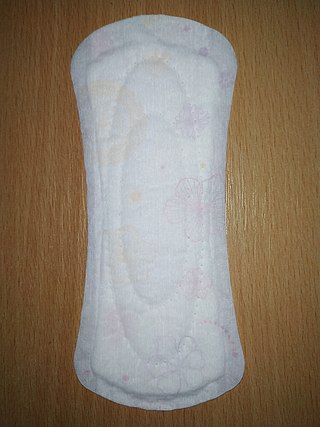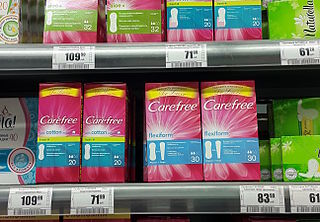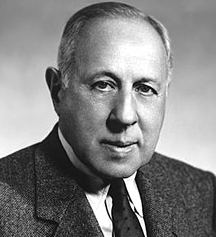
Band-Aid is a brand of adhesive bandages distributed by the consumer health company Kenvue, spun off from Johnson & Johnson in 2023. Invented in 1920, the brand has become a generic term for adhesive bandages in countries such as the United States, Canada, Australia, the Philippines, and others.

Kimberly-Clark Corporation is an American multinational personal care corporation that produces mostly paper-based consumer products. The company manufactures sanitary paper products and surgical & medical instruments. Kimberly-Clark brand name products include Kleenex facial tissue, Kotex feminine hygiene products, Cottonelle, Scott and Andrex toilet paper, Wypall utility wipes, KimWipes scientific cleaning wipes and Huggies disposable diapers and baby wipes.

The Scott Paper Company was the world's largest manufacturer and marketer of sanitary tissue products with operations in 22 countries. Its products were sold under a variety of well-known brand names, including Scott Tissue, Cottonelle, Baby Fresh, Scottex and Viva. Consolidated sales of its consumer and commercial products totalled approximately $3.6 billion in 1994.

A generic trademark, also known as a genericized trademark or proprietary eponym, is a trademark or brand name that, because of its popularity or significance, has become the generic term for, or synonymous with, a general class of products or services, usually against the intentions of the trademark's owner.

Kotex is an American brand of menstrual hygiene products, which includes the Kotex maxi, thin and ultra-thin pads, the Security tampons, and the Lightdays pantiliners. Most recently, the company has added U by Kotex to its menstrual hygiene product line. Kotex is owned and managed by Kimberly-Clark, a consumer products corporation active in more than 80 countries.
Mace is the brand name of an early type of aerosol self-defense spray invented by Alan Lee Litman in the 1960s. The first commercial product of its type, Litman's design packaged phenacyl chloride (CN) tear gas dissolved in hydrocarbon solvents into a small aerosol spray can, usable in many environments and strong enough to act as a deterrent and incapacitant when sprayed in the face.

Huggies is an American company that sells disposable diapers and baby wipes that is marketed by Kimberly-Clark. Huggies were first test marketed in 1968, then introduced to the public in 1977 to replace the Kimbies brand.

Tissue paper or simply tissue is a lightweight paper or, light crêpe paper. Tissue can be made from recycled paper pulp on a paper machine.
Kleercut is the name of a former campaign conducted by Greenpeace, the Natural Resources Defense Council, and others towards Kimberly-Clark. It lasted from 2004 to 2009. Kimberly-Clark is the world’s largest manufacturer of tissue products, most notably the Kleenex brand. According to its annual environmental report, the company purchases over 3.1 million metric tonnes of virgin fiber from logging companies annually. The Kleercut campaign claims that this fiber is derived from wood pulp from old growth forests. Kimberly-Clark claims that the forests in question are largely cut for timber. The Kleercut campaign claims that Kimberly-Clark support the clearcutting of such forests in Canada and the United States, including forests habitat for wolverine and threatened wildlife the woodland caribou. Kimberly-Clark has responded that many of its supplies are certified by the Sustainable Forestry Initiative or the Canadian Standards Association.

Facial tissue and paper handkerchief refers to a class of soft, absorbent, disposable papers that are suitable for use on the face. They are disposable alternatives for cloth handkerchiefs. The terms are commonly used to refer to the type of paper tissue, usually sold in boxes, that is designed to facilitate the expulsion of nasal mucus from the nose (nose-blowing) although it may refer to other types of facial tissues such as napkins and wipes.

Carefree is an American brand of pantyliners from Johnson & Johnson. In the US, the Carefree brand was formerly marketed by McNeil-PPC and currently being marketed by Edgewell Personal Care.

Scotties is a facial tissue brand originally owned by the Scott Paper Company, created in 1955.

Andrex is a British brand of toilet roll. It is owned by the American company Kimberly-Clark. The "Andrex Puppy", a Labrador Retriever puppy that appears on the company's television advertisements, is synonymous with the brand.
Trademark distinctiveness is an important concept in the law governing trademarks and service marks. A trademark may be eligible for registration, or registrable, if it performs the essential trademark function, and has distinctive character. Registrability can be understood as a continuum, with "inherently distinctive" marks at one end, "generic" and "descriptive" marks with no distinctive character at the other end, and "suggestive" and "arbitrary" marks lying between these two points. "Descriptive" marks must acquire distinctiveness through secondary meaning—consumers have come to recognize the mark as a source indicator—to be protectable. "Generic" terms are used to refer to the product or service itself and cannot be used as trademarks.

Irving Tissue Company Limited is a tissue products producing company, owned by J.D. Irving Limited. It has manufacturing locations in both Canada and the United States.
Kimberly-Clark de México(KCM) is a Mexican company that engages in the manufacture and commercialization of disposable products for daily use by consumers within and away-from home in Mexico and internationally. The company's products include diapers and childcare products, feminine pads, incontinence care products, bath tissue, napkins, facial tissue, hand and kitchen towels, wet wipes and health care products. Today the company has 8 000 direct employees and over 10 thousand indirect jobs.

Ernst Mahler was an Austrian chemist and leader of the Kimberly-Clark Corporation in Wisconsin. Mahler developed, refined, and commercialized various popular products and processes of papermaking. He was also instrumental in the foundation of the Institute of Paper Science and Technology (IPST) as well as the Technical Association of the Pulp and Paper Industry (TAPPI).

Halyard, formerly Kimberly-Clark Health Care, now part of Owens & Minor, sells sterilization wrap, facial protection, gloves, protective apparel, surgical drapes and gowns in more than 100 countries.
















